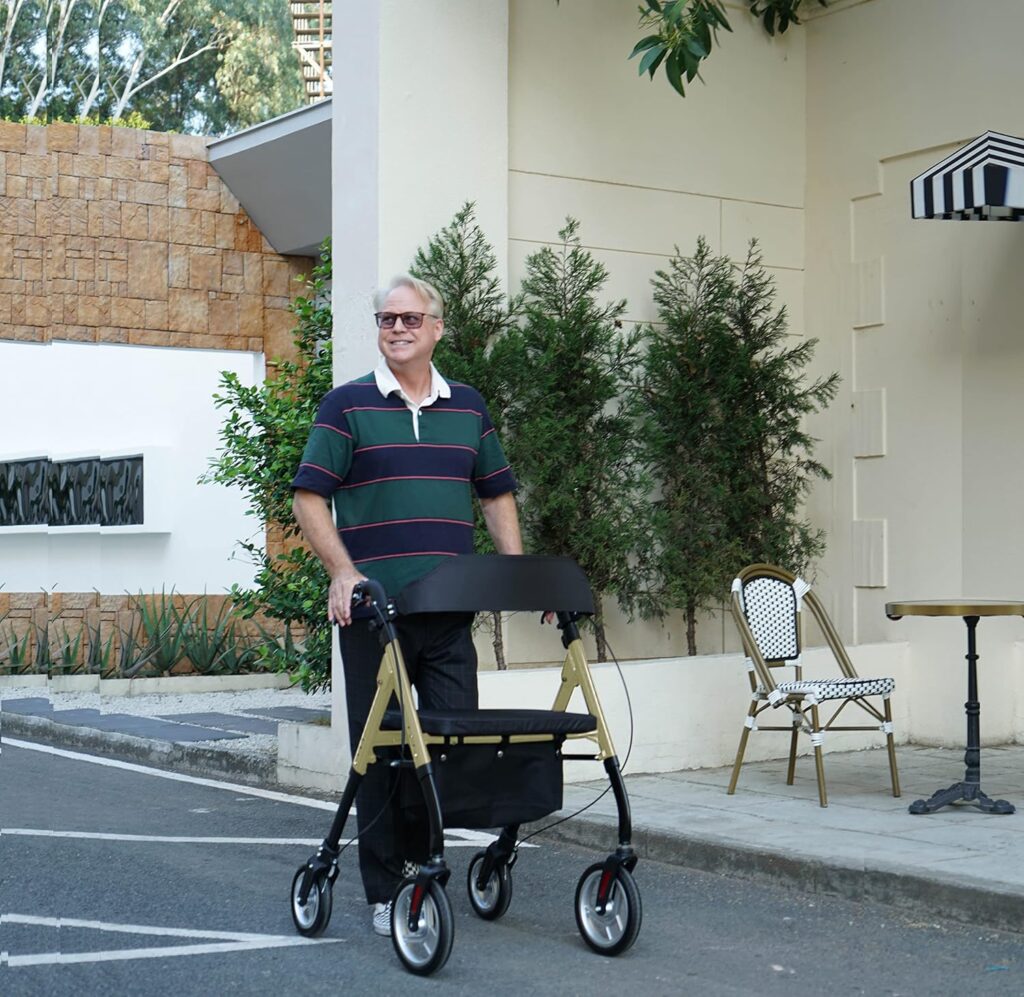Latest Blog
Types of Medical Walkers and Rollators: A Comprehensive Guide

Table of Contents
What Are Medical Walkers and Rollators?
Medical walkers and rollators are assistive devices designed to help people with mobility issues. They offer support to users who need assistance with balance or walking, preventing falls and promoting independence. Walkers generally come in two types: those without wheels (standard walkers) and those with wheels (rollators).
- Walkers typically have four legs and are designed to provide stability to users, especially those who have difficulty walking due to age, injury, or illness. Walkers must be lifted with each step.
- Rollators are walkers with wheels on all four legs and often include additional features like brakes, a seat for resting, and a basket for carrying personal items. They are designed to provide more mobility and comfort for users who can walk but need support for longer distances or uneven terrain.
Types of Walkers and Their Features
1. Standard Walkers
Standard walkers are the most basic type of walking aid, providing maximum stability. They are typically made from lightweight materials like aluminum, ensuring ease of use. These walkers have no wheels, so the user must lift the walker and place it in front of them with each step. This type of walker is ideal for those who need maximum support but have the strength to lift the walker.
Key Features:
- Stability: With no wheels, these walkers provide the best support for users who need help with balance.
- Lightweight Frame: Typically made from aluminum, making it easier to lift.
- Limited Mobility: Since the walker needs to be lifted with each step, they are less suited for long distances.
- Non-Slip Feet: Often equipped with rubber tips that provide traction and prevent slipping.
Best For: Individuals with severe mobility issues who need maximum stability for short distances.
2. Two-Wheeled Walkers
A two-wheeled walker is similar to a standard walker but has wheels on the front legs, making it easier to push forward. This reduces the amount of lifting required, which is helpful for users with limited upper body strength. Two-wheeled walkers still provide stability, but they are more maneuverable than standard walkers.
Key Features:
- Front Wheels: Makes it easier to push the walker forward without lifting.
- Rear Legs for Stability: The back legs do not have wheels, maintaining stability.
- Easier Movement: Ideal for users who have the strength to walk without needing extra support but still require some assistance.
Best For: Individuals who need assistance walking but have more strength and mobility than someone using a standard walker.
3. Four-Wheeled Walkers (Rollators)
Rollators are four-wheeled walkers that offer greater mobility and flexibility than two-legged or standard walkers. They come with features such as handbrakes, a seat for resting, and a storage pouch or basket. Rollators are designed for users who need mobility assistance but can walk for longer distances without lifting their walker.
Key Features:
- Four Wheels: Provides maximum mobility and ease of movement.
- Brakes: Hand brakes allow the user to control their speed and stop the walker.
- Seat for Resting: Offers a place to sit and rest during walks, ideal for individuals who get tired easily.
- Storage Basket or Bag: Convenient for carrying items such as water bottles, groceries, or personal belongings.
Best For: Users who can walk but need extra support, or those who may need to rest periodically while on the go.
Rollators: A Step Up in Mobility Assistance
Rollators are a more advanced type of walker, offering additional features that help improve the user’s comfort, mobility, and independence. With four wheels, rollators allow users to move without having to lift the walker. This makes them especially beneficial for those who have a limited range of motion or strength.Types of Rollators:
1. Standard Rollators
Standard rollators are the most common type of rollator, offering a simple design with a seat, handbrakes, and storage space. They are suitable for a wide range of users, from those needing basic mobility support to individuals with slightly more mobility.
Key Features:
- 4 wheels for easy movement
- Built-in seat for rest
- Basic storage basket or pouch
2. Heavy-Duty Rollators
Heavy-duty rollators are designed for larger individuals or those with more significant mobility needs. They offer stronger frames, wider seats, and higher weight capacities, ensuring greater comfort and stability.
Key Features:
- Reinforced frame for higher weight capacity
- Extra-wide seat for comfort
- Larger wheels for increased stability on uneven terrain
3. Tri-Wheel Rollators
Tri-wheel rollators have three wheels instead of four, making them more compact and suitable for use in tighter spaces. While they are not as stable as four-wheeled models, they are a good option for users with limited space at home or who need a more portable solution.
Key Features:
- 3 wheels for easier navigation in tight spaces
- Lightweight and compact design
- Ideal for short-distance use
Key Benefits of Using Walkers
- Provides more mobility on uneven surfaces
- Offers a seat for resting during walks
- Improves stability with the help of hand brakes
- Ideal for both indoor and outdoor use
Choosing the Right Mobility Aid: Walker vs. Rollator
When deciding between a walker and a rollator, there are several factors to consider:
| Factor | Walker | Rollator |
|---|---|---|
| Level of Mobility | Best for individuals with limited strength needing maximum stability | Ideal for those who can walk but need additional support for longer distances or occasional resting |
| Type of Terrain | Best for indoor use or smooth, even surfaces | Better suited for outdoor use, especially on uneven or rough terrain |
| User’s Strength and Independence | Requires more physical effort, as it must be lifted with each step | Provides greater independence with wheels, allowing users to move freely without lifting. |
| Comfort Needs | Typically doesn’t offer a seat for resting | Offers a built-in seat for resting during walks. |
Final Thoughts
Choosing the right mobility aid, whether it’s a walker or rollator, is a crucial decision for individuals with mobility challenges. While both options offer support, rollators provide enhanced features like mobility, comfort, and flexibility, making them ideal for those who need more independence.
On the other hand, standard walkers offer greater stability for users who need more assistance. It's important to evaluate your specific needs, walking environment, and comfort preferences to select the best option.
Frequently Asked Questions
References
The Walker Advisor is a team of experts dedicated to providing honest, research-based reviews of the best walkers and mobility aids for seniors. We gather real user feedback, both positive and negative, to help you make informed decisions. Our goal is to offer unbiased, transparent recommendations that ensure comfort, safety, and independence while meeting your unique needs and budget.
Welcome to The Walker Advisor Newsletter!
The Walker Advisor is committed to helping seniors and their families find the best mobility aids for safe and independent living.
Quick Links
Category
Copyright © 2025 The Walker Advisor All Rights Reserved
